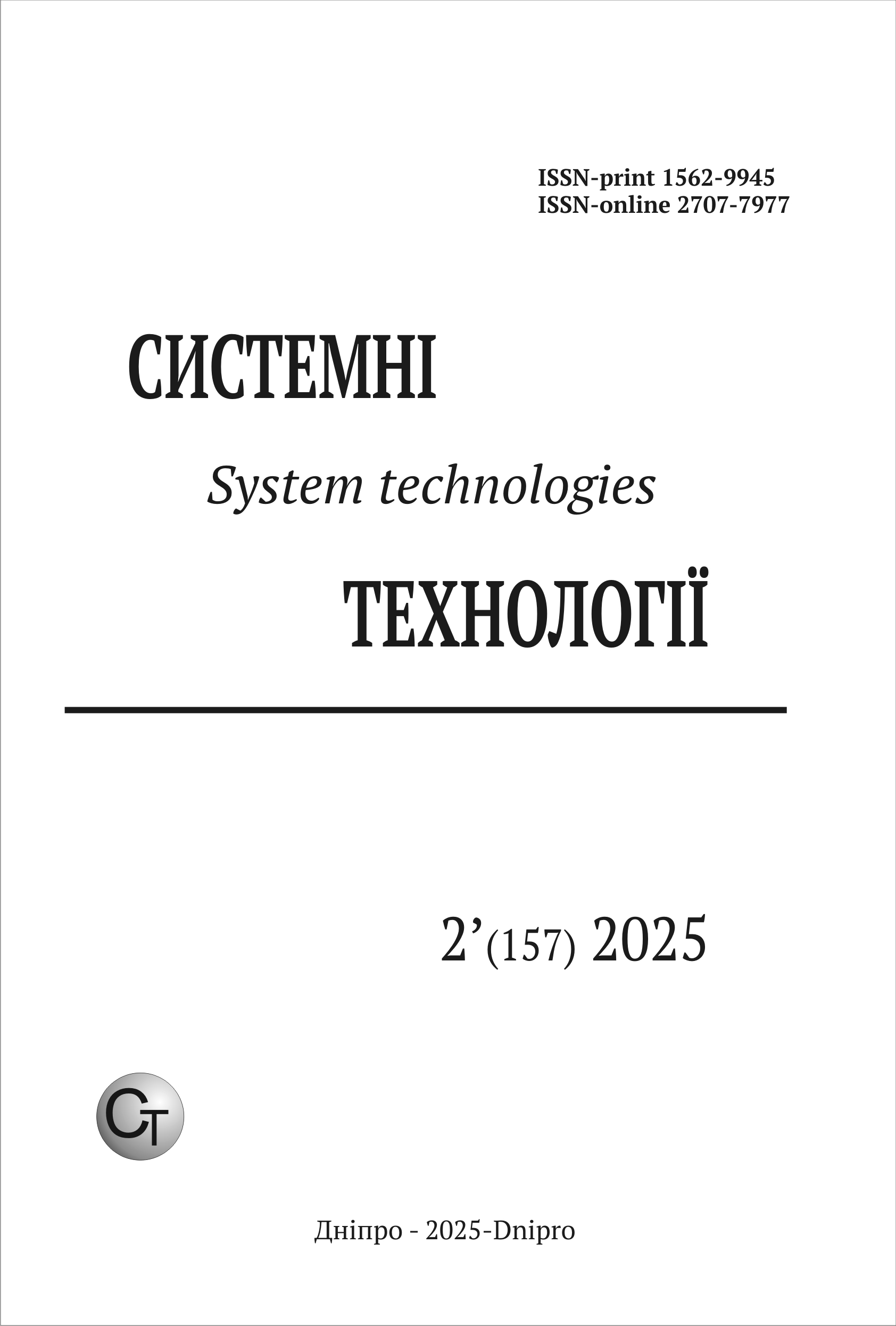DRONE VIDEO PROCESSING BY FRAGMENT ANALYSIS
DOI:
https://doi.org/10.34185/1562-9945-2-157-2025-01Keywords:
Video stream fragmentation; Ky Fan norm; Singular value decomposition; Drones, Object detection; Moving camera; Data Analysis, Video processingAbstract
This study focused on analyzing drone video to address the inherent complexity of processing videos captured with a moving camera. Each frame is divided into smaller fragments through a grid-based segmentation technique, enabling a localized and detailed motion analysis. Singular Value Decomposition (SVD) is applied to compute the Ki Fan norm for each fragment, enabling the detection of dynamic changes between consecutive frames. The fragment-level analysis allows the algorithm to robustly identify regions of interest and dif-ferentiate between global motion (camera movement) and local motion (object movement) despite challenges introduced by camera instability. The motion state is classified into four categories: stable camera with no object movement, stable camera with object movement, moving camera with no object movement, and moving camera with object movement. This fragment-based methodology enhances precision in dynamic scene analysis, offering a scal-able and efficient solution for applications such as video stabilization, object tracking, and real-time motion detection in complex environments.
References
Madhavan, R., Silva, T., Farina, F., Wiebbelling, R., Renner, L., & Prestes, E. (2018). Un-manned aerial vehicles for environmental monitoring, ecological conservation, and disaster management. In Technologies for Development: From Innovation to Social Impact (pp. 31-39). Springer International Publishing. DOI: 10.1007/978-3-319-91068-0_3
Mohsan, S. A. H., Othman, N. Q. H., Li, Y., Alsharif, M. H., & Khan, M. A. (2023). Un-manned aerial vehicles (UAVs): Practical aspects, applications, open challenges, security is-sues, and future trends. Intelligent Service Robotics, 16(1), 109-137. DOI: 10.1007/s11370-022-00452-4
Akbari, Y., Almaadeed, N., Al-Maadeed, S., & Elharrouss, O. (2021). Applications, data-bases and open computer vision research from drone videos and images: a survey. Artificial Intelligence Review, 54, 3887-3938. DOI: 10.1007/s10462-020-09943-1
Arafat, M.Y., Alam, M.M., & Moh, S. (2023). Vision-based navigation techniques for un-manned aerial vehicles: Review and challenges. Drones, 7(2), 89. DOI: 10.3390/drones7020089
Heakl, A., Youssef, F., Parque, V., & Gomaa, W. (2024). DroneVis: Versatile Computer Vision Library for Drones. arXiv preprint arXiv:2406.00447. DOI: 10.48550/arXiv.2406.00447
Rohan, A., Rabah, M., & Kim, S. H. (2019). Convolutional neural network-based real-time object detection and tracking for parrot AR drone 2. IEEE access, 7, 69575-69584. doi: 10.1109/ACCESS.2019.2919332
Han, S., Shen, W., & Liu, Z. (2016). Deep drone: Object detection and tracking for smart drones on embedded system. URL https://web. stanford. edu/class/cs231a/prev_projects_2016/deepdrone-object__2_. pdf.
Yazdi, M., & Bouwmans, T. (2018). New trends on moving object detection in video im-ages captured by a moving camera: A survey. Computer science review, 28, 157-177. DOI: 10.1016/j.cosrev.2018.03.001
Yang, J., Xie, X., & Wang, Y. (2017, April). Design of video surveillance and tracking sys-tem based on attitude and heading reference system and PTZ camera. In 2017 5th Interna-tional Conference on Computer-Aided Design, Manufacturing, Modeling and Simulation (CDMMS 2017) (Vol. 1834, No. 1, p. 040016). DOI: 10.1063/1.4981612
Chen, P., Dang, Y., Liang, R., Zhu, W., & He, X. (2017). Real-time object tracking on a drone with multi-inertial sensing data. IEEE Transactions on Intelligent Transportation Sys-tems, 19(1), 131-139. doi: 10.1109/TITS.2017.2750091
Dames, P., Tokekar, P., & Kumar, V. (2017). Detecting, localizing, and tracking an un-known number of moving targets using a team of mobile robots. The International Journal of Robotics Research, 36(13-14), 1540-1553. DOI: 10.1177/0278364917709507
Leal-Taixé, L., Milan, A., Schindler, K., Cremers, D., Reid, I., & Roth, S. (2017). Track-ing the trackers: an analysis of the state of the art in multiple object tracking. arXiv preprint arXiv:1704.02781. DOI: 10.48550/arXiv.1704.02781
Risse, B., Mangan, M., Del Pero, L., & Webb, B. (2017). Visual tracking of small animals in cluttered natural environments using a freely moving camera. In Proceedings of the IEEE international conference on computer vision workshops (pp. 2840-2849). https://openaccess.thecvf.com/content_ICCV_2017_workshops/papers/w41/Risse_Visual_Tracking_of_ICCV_2017_paper.pdf
Bouwmans, T. (2014). Traditional and recent approaches in background modeling for foreground detection: An overview. Computer science review, 11, 31-66. DOI: 10.1016/j.cosrev.2014.04.001
Yilmaz, A., Javed, O., & Shah, M. (2006). Object tracking: A survey. Acm computing surveys (CSUR), 38(4), 13-es. DOI: 10.1145/1177352.1177355
Wren, C. R., Azarbayejani, A., Darrell, T., & Pentland, A. P. (1997). Pfinder: Real-time tracking of the human body. IEEE Transactions on pattern analysis and machine intelli-gence, 19(7), 780-785. doi: 10.1109/34.598236
Zhai, W., Xiong, X., Mo, G., Xiao, Y., Wu, C., Xu, Z., & Pan, J. (2024). A Bagging-SVM field-road trajectory classification model based on feature enhancement. Computers and Elec-tronics in Agriculture, 217, 108635. DOI: 10.1016/j.compag.2024.108635
Zhai, W., Xu, Z., Pan, J., Guo, Z., & Wu, C. (2024). A general image classification model for agricultural machinery trajectory mode recognition. Computers and Electronics in Agri-culture, 227, 109629. DOI: 10.1016/j.compag.2024.109629
Bouwmans, T., Sobral, A., Javed, S., Jung, S. K., & Zahzah, E. H. (2017). Decomposition into low-rank plus additive matrices for background/foreground separation: A review for a comparative evaluation with a large-scale dataset. Computer Science Review, 23, 1-71. DOI: 10.1016/j.cosrev.2016.11.001
T. Bouwmans, T., Aybat, N. S., & Zahzah, E. H. (Eds.). (2016). Handbook of robust low-rank and sparse matrix decomposition: Applications in image and video processing. CRC Press. https://dl.acm.org/doi/abs/10.5555/2994445
Ebadi, S. E., Ones, V. G., & Izquierdo, E. (2015, September). Efficient background sub-traction with low-rank and sparse matrix decomposition. In 2015 IEEE International Confer-ence on Image Processing (ICIP) (pp. 4863-4867). IEEE. doi: 10.1109/ICIP.2015.7351731.
Wu, Y., He, X., & Nguyen, T. Q. (2015). Moving object detection with a freely moving camera via background motion subtraction. IEEE Transactions on Circuits and Systems for Video Technology, 27(2), 236-248. doi: 10.1109/TCSVT.2015.2493499
Tomasi, C. (2012). Histograms of oriented gradients. Computer Vision Sampler, 1-6.
Koliada, M. “Ky fan norm application for video segmentation”. Herald of Advanced In-formation Technology, 2020;1(3), 345-351. DOI: 10.15276/hait.01.2020.1
Mashtalir, S., & Lendel, D. “Video pre-motion detection by fragment processing”. CEUR Workshop ProceedingsVolume. 2024; 3790, pp. 342 – 351. https://www.scopus.com/inward/record.uri?eid=2-s2.0-85207837522&partnerID=40&md5=26529ee16efb141face273bd943660d5
Mashtalir, S. V. & Lendel D. P. “Video fragment processing by Ky Fan norm”, Appl. Asp. Inf. Technol. 2024; 7.1: 59 68. DOI: DOI: 10.15276/aait.07.2024.5
Sergii V. Mashtalir, Dmytro P. Lendel (2024). Moving object shape detection by fragment processing. Herald of Advanced Information Technology. 7(4), 414-423. DOI: 10.15276/hait.07.2024.30
Downloads
Published
Issue
Section
License
Copyright (c) 2025 System technologies

This work is licensed under a Creative Commons Attribution 4.0 International License.















